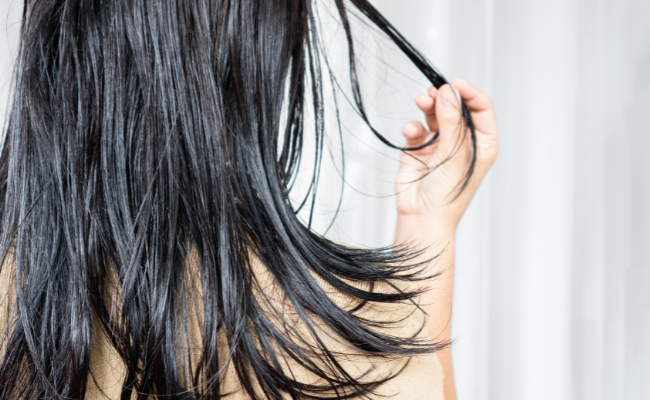How to Treat Oily Hair?
- November 02, 2023
- No Comments

What is Oily Hair?
Oily hair is a common condition characterized by an excess production of sebum, the natural oil produced by the scalp. Sebum is essential for keeping hair moisturized and healthy, but an overproduction in Sebum can lead to oily and greasy hair, making it appear dull and limp. Oily hair can be caused by various factors, including genetics, hormonal imbalances, diet, and environmental factors. If you blot tissue paper on the scalp of a normal hair type two days after washing, it will leave a small translucent area. An oily scalp type will be more saturated, and the hairs will clump, and dry scalp type you may not see anything on the tissue paper.
Why Does Hair Get Oily?
Several factors contribute to the development of oily hair. One of the primary reasons is genetics; some people are naturally predisposed to produce more sebum. Hormonal changes, especially during puberty, pregnancy, or menstruation, can also increase sebum production. Additionally, a poor diet, stress, and using harsh hair products that strip the scalp of its natural oils can trigger excessive oiliness.
How to Manage Oily Hair?
Managing oily hair requires a combination of proper hair care practices and lifestyle changes.
- Use the Right Shampoo: Opt for a mild, clarifying shampoo that helps to control oil without over-drying the scalp. Look for products containing ingredients like tea tree oil, salicylic acid, or witch hazel, which have natural astringent properties.
- Frequent Washing: Washing your hair regularly helps remove excess oil and prevent buildup. Aim to wash your hair every other day or as needed to keep it clean and fresh.
- Avoid Over-Brushing: Brushing your hair too often can stimulate the production of more oil. Limit brushing to once or twice a day, and use a wide-toothed comb to prevent excessive pulling and oil distribution.
- Balanced Diet: Maintain a balanced diet rich in vitamins, minerals, and antioxidants. Avoid excessive consumption of oily and greasy foods, as they can contribute to oily scalp and hair.
- Stay Hydrated: Drink an adequate amount of water to keep your body and scalp hydrated. Proper hydration helps regulate sebum production and promotes overall scalp health.
Treatment Solutions for Oily Hair:
- Lemon Juice: Mix lemon juice with water and use it as a final rinse after shampooing. The acidic properties of lemon help balance the scalp's pH and control oil.
- Aloe Vera Gel: Apply aloe vera gel to your scalp and leave it for 15-20 minutes before washing. Aloe vera has soothing and astringent properties that can help reduce oiliness.
- Apple Cider Vinegar: Dilute apple cider vinegar with water and use it as a rinse after shampooing. It helps remove excess oil and leaves the hair shiny.
- Scalp Exfoliation: Regular scalp exfoliation treatments can remove dead skin cells and excess oil, promoting a healthier scalp. Consult a professional hairstylist or dermatologist for specialized scalp treatments.
- Keratin Treatment: Keratin treatments can help control frizz and oiliness, making the hair more manageable. These treatments are usually done in salons and provide long-lasting results.
Benefits of Managing Oily Hair:
- Improved Hair Health: Proper management of oily hair leads to a healthier scalp and hair. By keeping the scalp clean and balanced, you reduce the risk of scalp infections and other hair-related issues.
- Enhanced Appearance: Oily hair often appears greasy and unkempt. Managing oiliness results in hair that looks clean, shiny, and voluminous, enhancing your overall appearance and confidence.
- Prevention of Hair Problems: Addressing oily hair prevents problems such as dandruff and itchiness, which are often associated with excessive oil production. A healthy scalp is essential for preventing these issues.
- Easier Styling: When your hair is not weighed down by excess oil, it becomes easier to style. It holds styles better, making it simpler to experiment with different hairstyles and looks.
Comments (0)